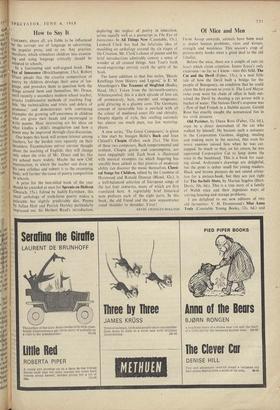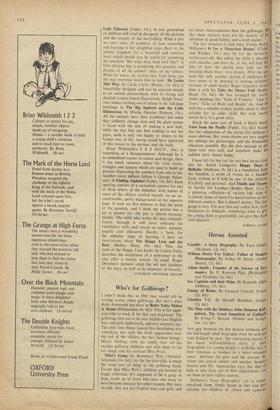Of Mice and Men
FROM Aesop onwards, animals have been used to depict human problems, vices and virtues, strength and weakness. This seaion's crop of picture-story books owes a great deal to the old fabulist.
Before the mice, there are a couple of cats (at least) which claim attention. James Joyce's only excursion--as far as I know—into this field, The Cat and the Devil (Faber, 15s.), is a neat little tale of how the Devil built a bridge for the people of Beaugency, on condition that he could claim the first person to cross it. The Lord Mayor (who even wore his chain of office in bed) out- witted the Devil by shooing a cat across with a bucket of water. The furious Devil's response was a flow of bad French in a Dublin accent. Gerald Rose has exactly caught the nonsensical fun in his vivid pictures.
Old Perisher, by Diana Ross (Faber, 12s. 6d.), must be a direct descendant of the cat who walked by himself. He became such a nuisance in the Corporation Gardens, digging, stealing and making nests in the narcissi, that even his worst enemies missed him when he was cat- napped. So much so that, on his return, he was appointed Corporation Cat to keep down the mice in the bandstand. This is a book for read- ing aloud. Ardizzone's drawings are delightful, but the print is rather small for young readers. Black and brown pictures do not sound attrac- tive for a picture-book, but they are just right for The So-Safe Store, by Marian Sugden (Hart- Davis, 10s. 6d.). This is a true story of a family of Welsh mice and their ingenious ways of solving housing and storage problems.
I am delighted to see new editions of two old favourites: V. H. Drummond's Miss Anna Truly (Constable Young Books, 12s. 6d.) and
Lady Talavera (Faber, 15s.). A new generation of children will revel in the gaiety of the pictures and the vivacity of the storytelling. What a pity we can't solve all problems of land ownership and housing in her delightful ways. Back to the animal kingdom for a beautiful and sensitive book which should also be useful for answering the question, 'But what does God look like?' A little African boy is pondering this question and dreams of all the animals' ideas on the subject. When he wakes, he realises that 'God looks just the way everyone wants him to look.' He Looks This Way, by Cecile Curtis (Warne, 12s. 6d.), is beautifully designed and can be enjoyed simply as an animal picture-book, with its strong and detailed scraper-board illustrations. Ralph Stead- man makes exciting use of colour in his full-page paintings in The Big Squirrel and the Little Rhinoceros, by Mischa Damjan (Dobson, 15s.). All the animals have their problems, but when they suddenly change sizes and the giant mouse is faced with the task of making a new hole, while the tiny lion can find nothing to eat but grass, each is only too happy to return to his former way of life. Aesop would have approved of this lesson to the envious and the bully.
Brian Wildsmith's 1 2 3 (O.U.P., 16s.) is something of a disappointment. Although he is an undoubted master of colour and design, there is too much sameness about his vivid circles, triangles and squares which are used to build up pictures illustrating the numbers from one to ten. Another more definite failure is George Adam- son's A Finding Alphabet (Faber, 13s. 6d.). Each opening consists of a surrealistic picture for two or three letters of the alphabet, with, names of some of the objects printed (mostly on an un- comfortable, spotty background) on the opposite page. It took me five minutes to find the prow of the. gondola, and I think the printer has a lot to answer for —the pier is almost unrecog- nisable. The child who works his way conscien- tiously through it will have enlarged his vocabulary with such words as mitre, minaret, pagoda and silhouette. Hardly a book for the alphabet stage of learning. I have no reservations about The Happy Lion and the Bear (Bodley Head, 10s. 6d.). This, the sixth of the Happy Lion books by Louise Fatio, describes the acceptance of a newcomer to the zoo, after a stormy arrival. As usual, Roger Duvoisin's pictures catch the wit and kindness of the story, as well as its moments of ferocity.
ELIZABETH HENNIK ER HEATON



































 Previous page
Previous page